Soondubu jjigae warms my soul with the trademark spicy, briny and smoky flavors I love most about Korean comfort food. It’s brimming with seafood like shrimp, squid and clams – and the softest silken tofu. While I prefer my pescatarian version here, this recipe is also vegan adaptable.
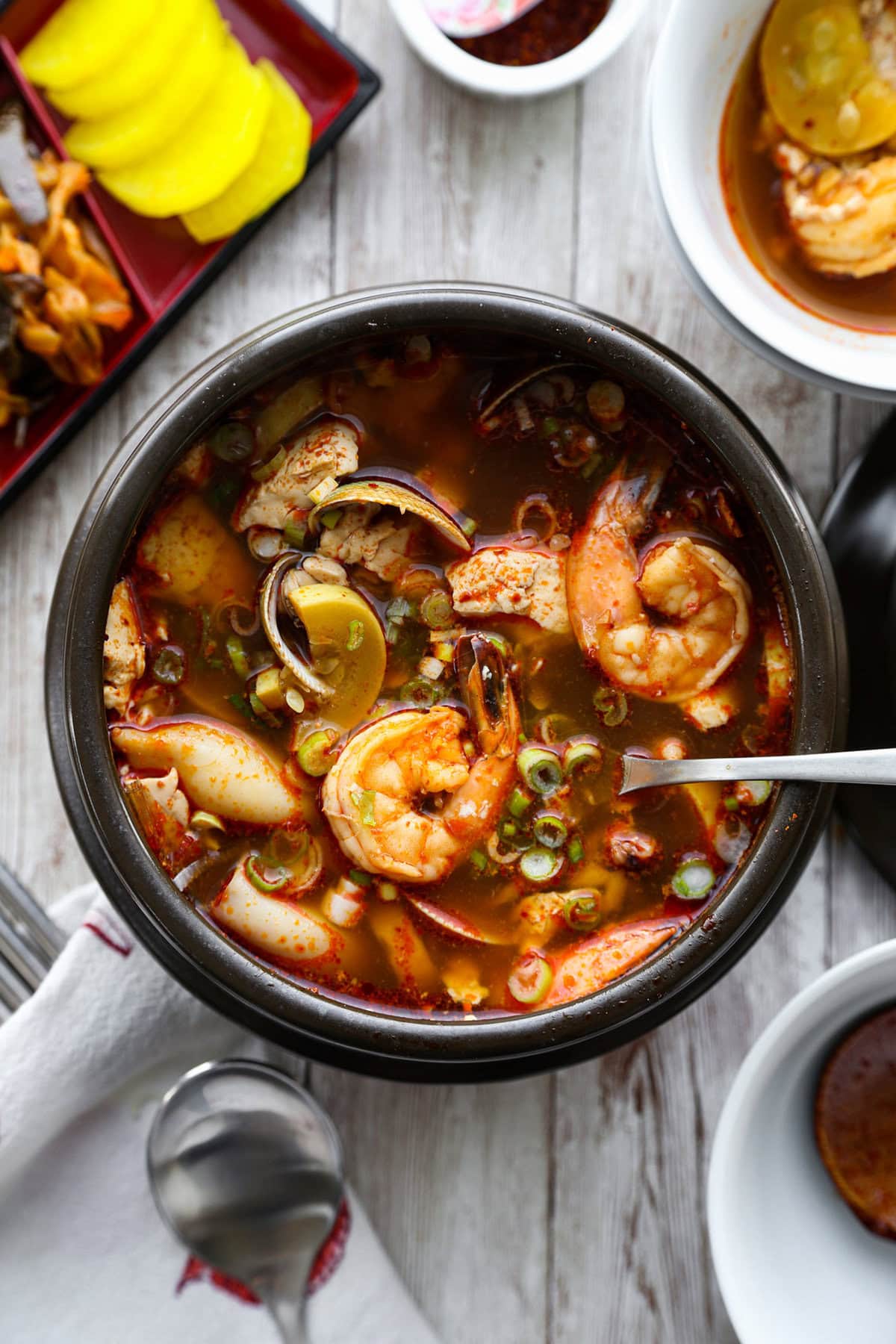
When I first set out to make soondubu jjigae at home, I knew the pressure was on to get it right. It’s one of Korea’s most popular dishes for a reason. I’m powerless to the pull of shellfish and melt-in-your-mouth curds of soft tofu simmered in a spicy anchovy broth peppered with Korean chili flakes. That passion for flavor lit the fire in me. My seafood centric version is called Haemul Sundubu Jjigae.
But jjigae comes in many forms. I’ve also made kimchi jjigae and doenjang jjigae at home. And this Korean seafood stew can easily be made with pork or beef instead. I also love that I can control the spice levels fairly easily. While I’d say this recipe is rather spicy as written, I regularly augment the amount of heat that goes into my broth by adding more or less gochugaru (Korean chili flakes).
Table of contents
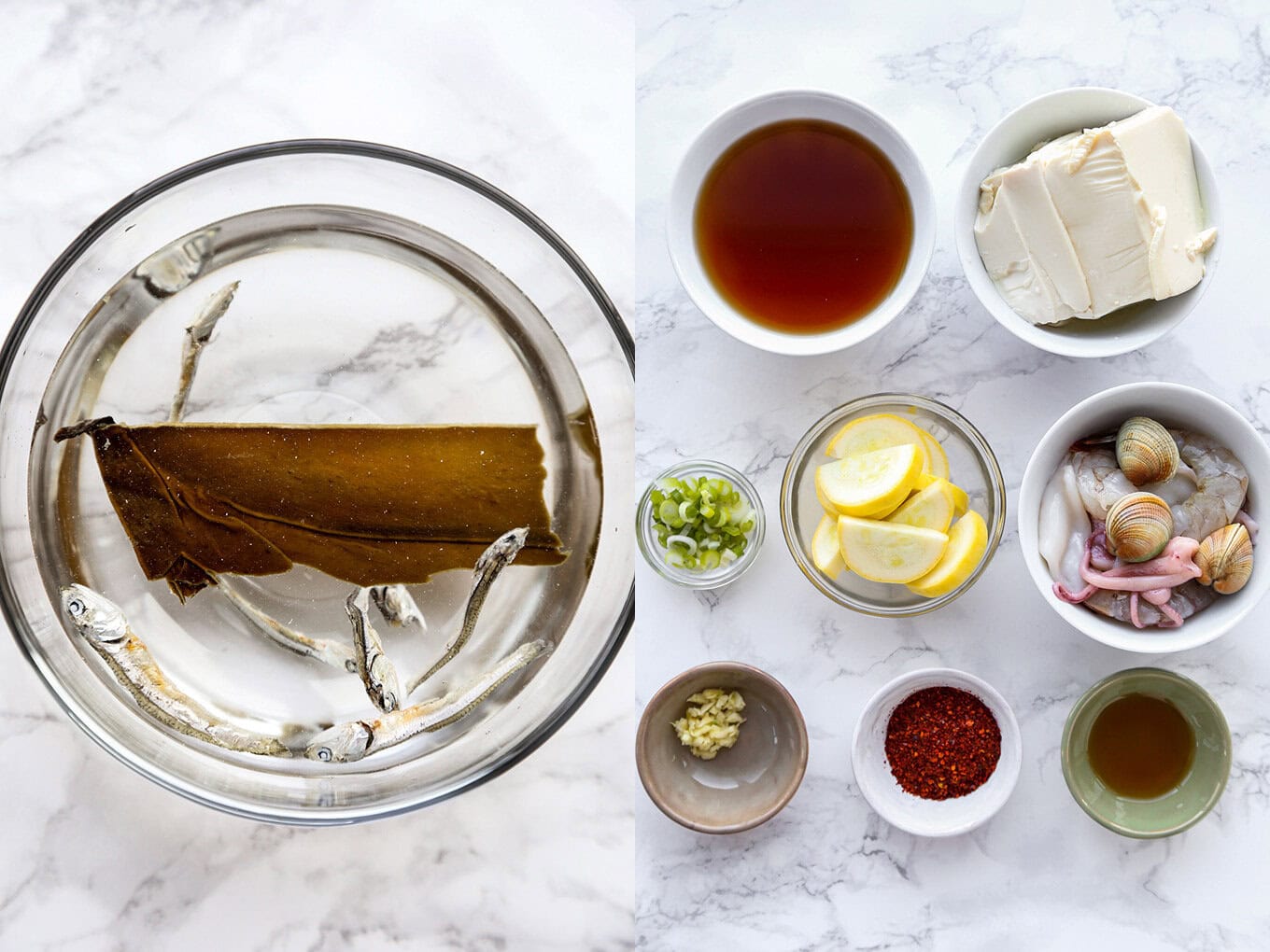
Ingredients
Scroll to the bottom of this page for the full recipe steps and measurements.
- Sesame Oil: I use sesame oil to briefly fry the garlic and chili flakes on low heat. It also adds great toasted nuttiness.
- Garlic: One large garlic clove should do the trick.
- Korean Chili Flakes: Gochugaru are sun dried Korean chili flakes. They’re smoky and medium in heat. I consider these the backbone of spice in the Korean flavor palate.
- Silken Tofu: The Korean tofu commonly sold in a tube, is super silky and soft. But using regular silken tofu from brands like House Foods or Morinaga also works really well.
- Yellow Squash: The squash adds another tender texture. I use green zucchini whenever I can’t find yellow squash.
- Seafood: Any mix of shellfish works here. I use squid, shrimp, mussels and clams. It infuses the broth with rich and briny flavors of the sea.
- Green Onions: As a crunchy garnish.
- Broth: I make my base broth with mixture of kelp, dried anchovies, water, soy sauce, and salt.
- Egg: Optional but recommend!
Variations
- Make it with meat. Meat lovers can sub out the shellfish for thinly sliced pork belly or beef.
- Go vegan instead. Instead of anchovies, make the broth with 3 large dried shiitake mushrooms. And instead of the shellfish, substitute button mushrooms and/or soy strips.
- Make it spicier – or milder. Just use more or less gochugaru chili flakes.
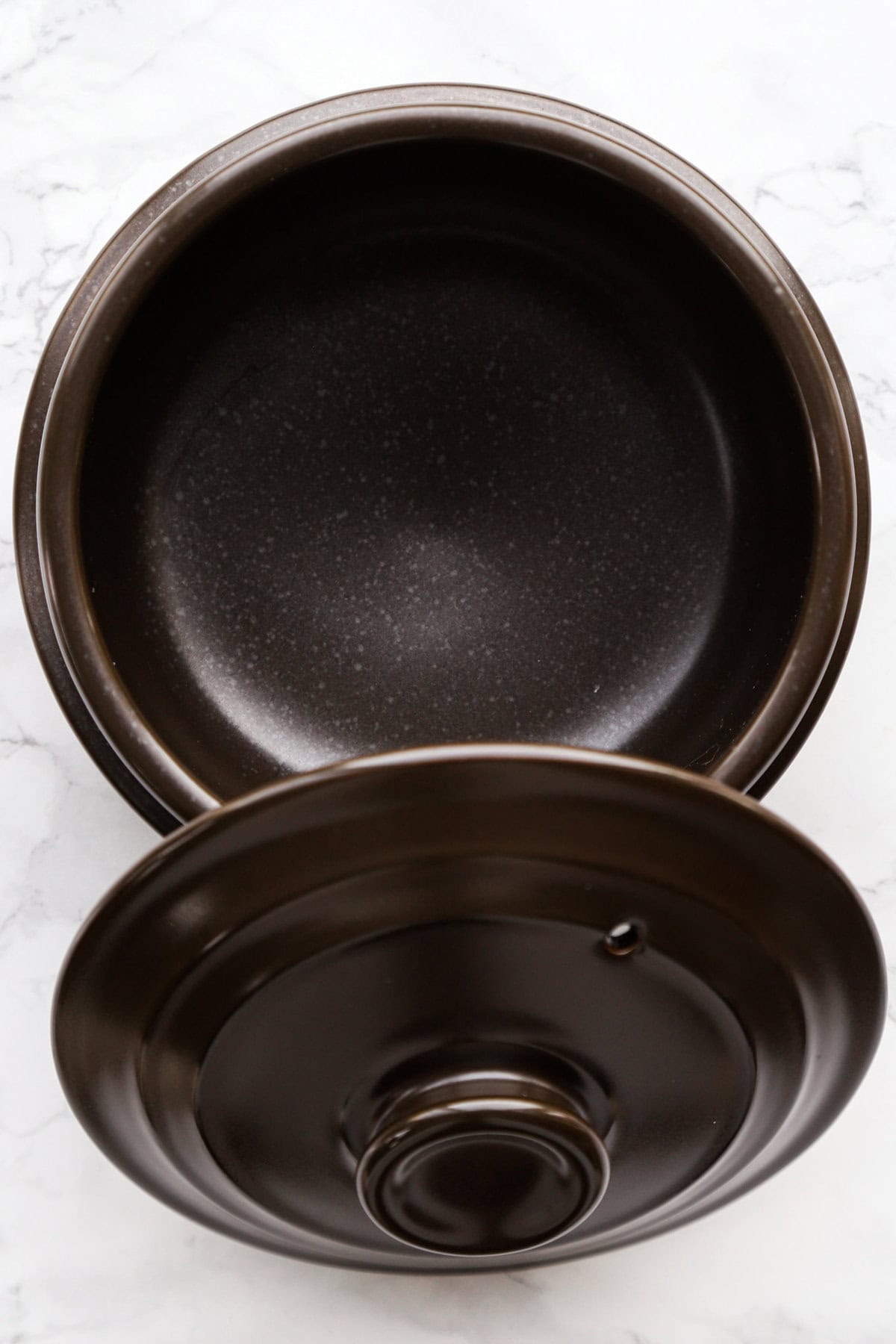
Equipment
- Small pot
- Strainer
- Chef’s knife
- Dolsot pot (stone bowl)
What’s a good dolsot pot substitute?
I find that the best substitute for a dolsot pot is a clay or ceramic pot since both are capable of retaining heat after being removed from a heat source. Just be careful with drastic changes in temperature. It’s important to slowly increase or decrease the pot’s temperature to prevent it from cracking.
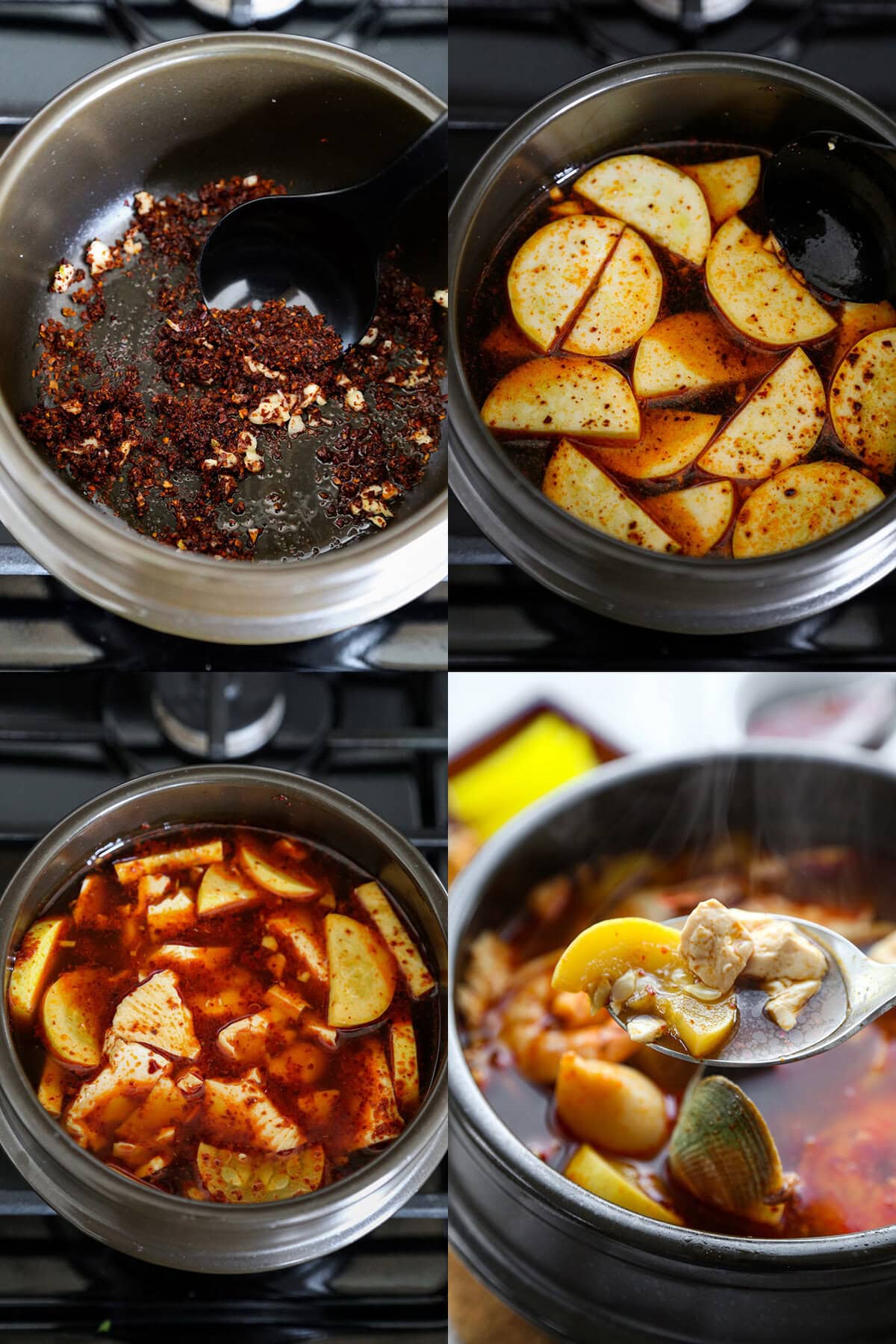
How To Make It
- Prep the broth. Remove the white dust on the kelp by gently wiping it down with a wet kitchen towel. Put the kelp in a small pot along with the water and dried anchovies. Leave for 30 minutes at room temp. Then bring the water to a boil. Once boiling, remove the kelp. Turn the heat down to a low simmer, cover for 15 minutes.
- Strain and season the broth. Turn the heat off, drain the broth through a sieve. Sir in the soy sauce and salt.
- Cook garlic and chili flakes. Place the dolsot pot on a burner and turn the heat to low. Add the sesame oil, Korean chili flakes and garlic and stir for 3 minutes.
- Add broth, squash and tofu. Add the anchovy broth and squash and stir. Turn the heat up and bring the broth to a boil. Lower the heat and add the tofu by gently breaking it.
- Add seafood. Add the shellfish and cook until cooked through.
- Garnish, serve. Top the stew with chopped scallions (and you can crack an egg on top – which will cook as the stew continues to bubble in the stone pot). Serve with rice.
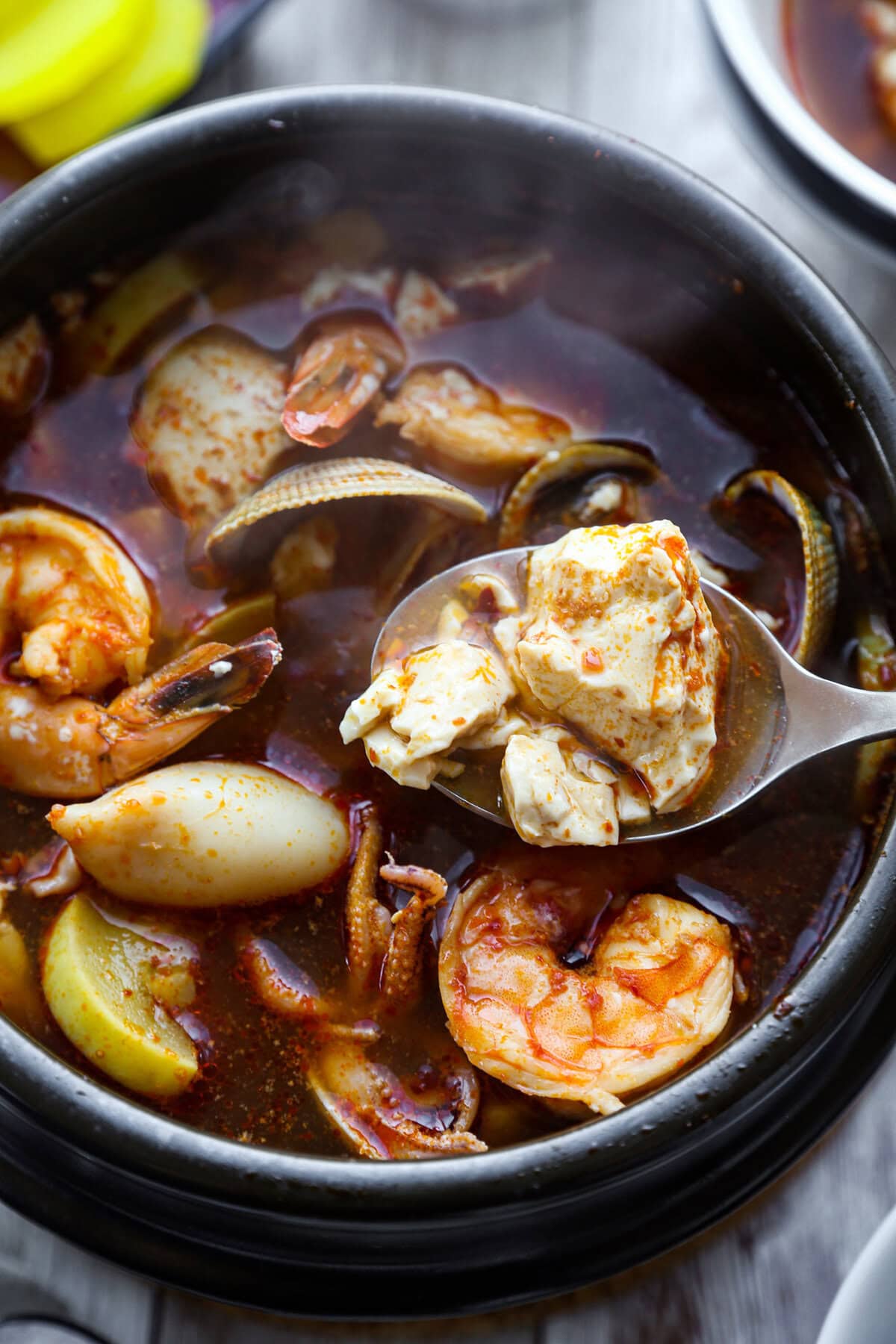
Expert Tip
Soondubu is typically served in the same pot that it’s cooked in, while the broth is still bubbling. That means it’s HOT. When I move the dolsot pot from the stovetop to a table, I place a cork trivet or a heat proof mat on the table first. Then I put the lid on the dolsot pot, use oven mitts that have a good grip (I don’t use kitchen towels as they can unfold or slip), and shout coming through as I carefully travel from point A to B.
What to Serve With Soondubu
Soodubu is traditionally served with a side of steamed rice. But my absolute favorite part of any Korean meal is the banchan (traditional Korean side dishes). Here are a few reader favorites:
- Spicy Cucumber Salad (Oi Muchim)
- Korean Bean Sprout Salad (Sookju Namul)
- Vegan Kimchi
- Steamed Egg (Gyeranjjim)
- Steamed Korean Eggplant (Gaji Namul)
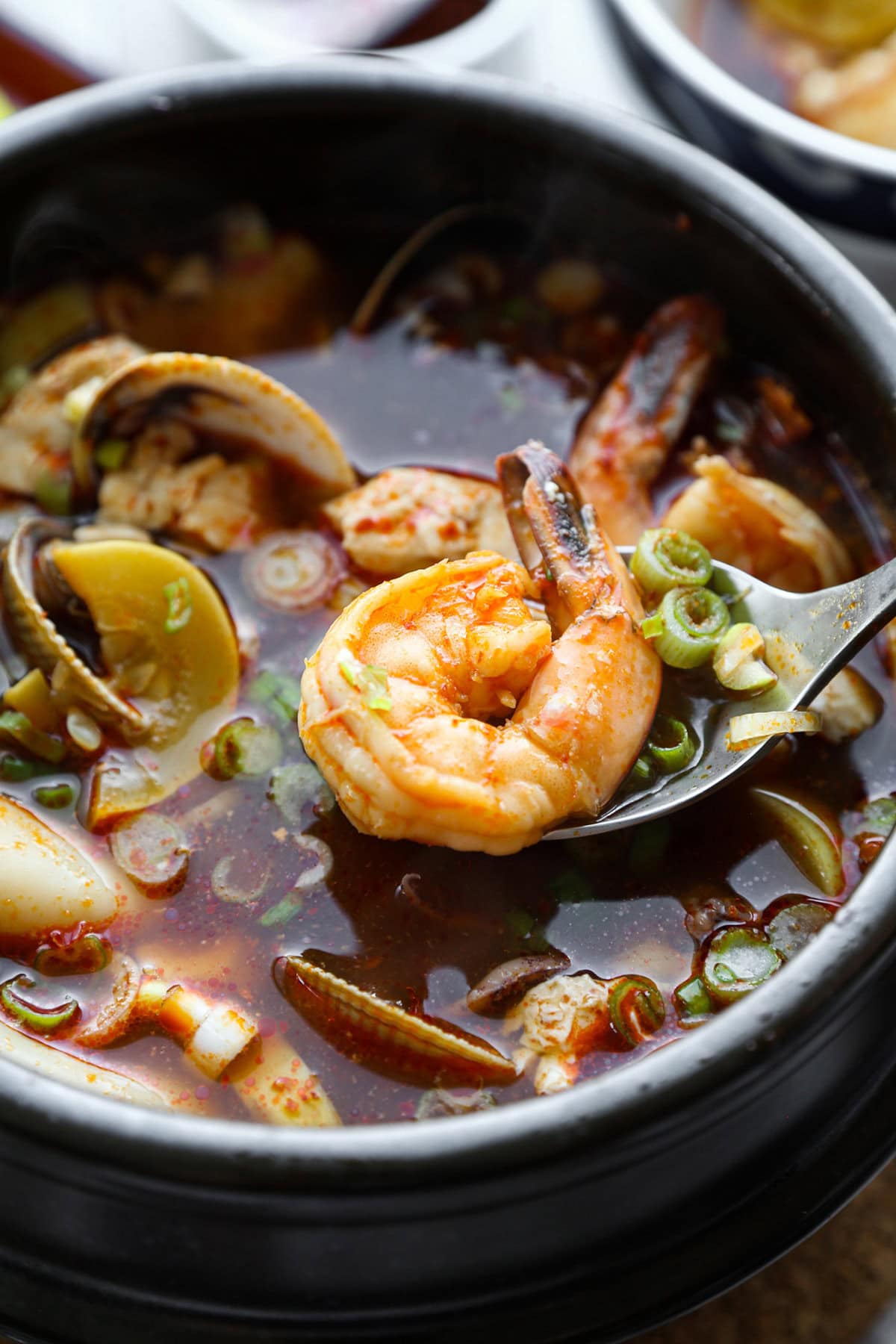
Storage
Seafood soondubu made with shellfish should be eaten immediately to prevent the shellfish from overcooking. I don’t recommend storing leftovers for more than a day.
For vegan soondubu – or if you are making it with meat like pork or beef – keep leftovers in an airtight storage container and refrigerate for up to 3 days.
Frequently Asked Questions
The only overtly spicy ingredient is the gochugaru. And even that’s more of a smoky heat rather than full-on fire. If you’re sensitive to spice, just use half of the recommended gochugaru. You can always add more later if you feel that it needs a boost.
Since soondubu is usually served in the stone pot it was cooked in, the temperature of the stew stays hot longer. That means the seafood continues to cook even after you’ve taken it off the stovetop. My suggestion is to pull the dolsot from the stove as soon as the seafood is properly cooked – and serve immediately.
Did you try this recipe? Are there changes you made that you would like to share? Share your tips and recommendations in the comments section below!
Print
Soondubu Jjigae (Korean Spicy Tofu Stew)
- Prep Time: 10 minutes
- Cook Time: 27 minutes
- Total Time: 37 minutes
- Yield: 2 1x
- Category: Stew
- Method: Simmering
- Cuisine: Korean
Description
Soondubu is a traditional spicy Korean tofu stew. I love the natural sour, briny smokiness. Try it tonight!
Ingredients
- 1 tablespoon sesame oil
- 1 teaspoon minced garlic
- 1 1/2 tablespoons Korean chili flakes (gochugaru) – use less to make it milder (start with 1/2 tablespoon, you can always add more later)
- 12oz (350g) silken tofu, drained
- 3oz (85g) yellow squash or zucchini, cut into half moons
- 7oz (200g) mixed shellfish such as shrimp, squid, mussels, clams – Vegans can use button mushrooms instead
- 2 green onions, finely chopped
- 1 egg (optional)
Broth:
- 2-inch piece dried kelp
- 7 dried anchovies – vegans use 3 dried shiitake mushrooms instead
- 1 1/2 cup water
- 2 teaspoons soy sauce
- 1/2 teaspoon salt
Instructions
- Prepare the broth. Wipe the kelp with a wet kitchen towel or paper towel to remove the white dust. Put the kelp, anchovies, and water in a pot and leave at room temperature for 30 minutes. After soaking, place pot on the stovetop and turn the heat to medium. As soon as the water starts to boil, remove the kelp. Turn down the heat to low, cover, and simmer for 15 minutes.
- Strain and season the broth. After simmering, turn the heat off and strain the broth through a sieve. Discard the anchovies. Add soy sauce and salt to the broth. Stir and set aside.
- Cook garlic and chili powder. Put the sesame oil, garlic, and Korean chili flakes in the dolsot pot (stone bowl) and set it over a gas burner on low heat. Stir with a wooden or plastic spoon for 3 minutes, stirring constantly.
- Add broth, squash and tofu. Add the anchovy broth and the chopped squash to the dolsot pot. Stir and bring to a boil. Lower the heat to medium-low and carefully add the silken tofu. Break it up a little using the spoon and cook for 8 minutes.
- Add seafood. Stir in the shellfish and cook for 3-4 minutes, until the shellfish is cooked through.
- Garnish and serve. Top with chopped scallions and an egg (if using). Serve with a side of white rice.
Notes
Soondubu made with shellfish should be eaten immediately to prevent the shellfish from overcooking. For vegan – or if you are making it with meat like pork or beef – keep leftovers in an airtight storage container and refrigerate for up to 3 days.
Nutrition
- Serving Size: 1 bowl
- Calories: 249
- Sugar: 1.3g
- Sodium: 857.2mg
- Fat: 12.5g
- Saturated Fat: 1.7g
- Unsaturated Fat: 5.6g
- Trans Fat: 0g
- Carbohydrates: 6.5g
- Fiber: 1.8g
- Protein: 29.5g
- Cholesterol: 159.7mg















How big of a bowl are we talking about if I want to portion this for myself? Was wondering if you could provide a reference.
Hi Alex! Bowl size would be like a medium bowl of soup. I personally would feel comfortable following the full recipe and saving half for later. It’s not a ton and if you don’t eat it with any rice, you may even be able to eat the entire soup on your own in one sitting 🙂
What does kelp look like and where do you buy it ?
Thank you for creating this wonderful recipe!! The best kimchi soondubu jjigae ever. I wish I can share a photo here in the comment section! Also the video was super helpful ♡
Thank you so much Dustin! 🙂